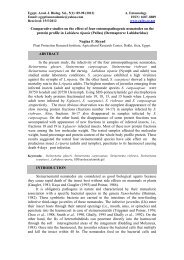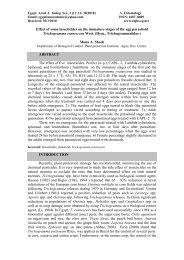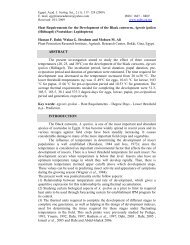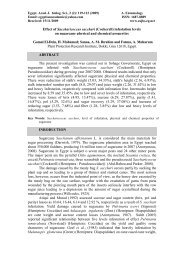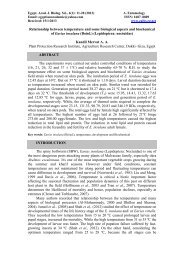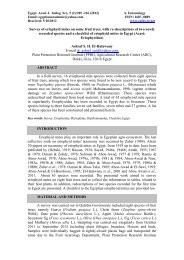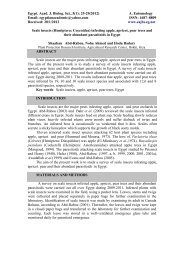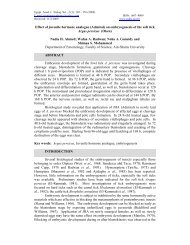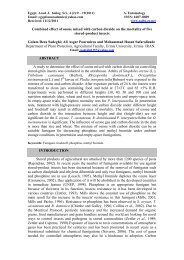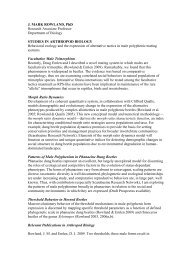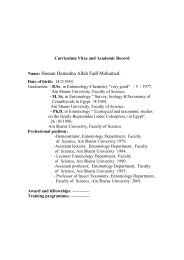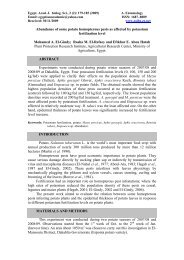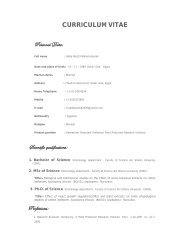Ant diversity at Sunut forest, Khartoum, Sudan - egyptian academic ...
Ant diversity at Sunut forest, Khartoum, Sudan - egyptian academic ...
Ant diversity at Sunut forest, Khartoum, Sudan - egyptian academic ...
You also want an ePaper? Increase the reach of your titles
YUMPU automatically turns print PDFs into web optimized ePapers that Google loves.
Egypt. Acad. J. Biolog. Sci., 6(1):43-46 (2013) A. Entomology<br />
Email: <strong>egyptian</strong><strong>academic</strong>@yahoo.com ISSN: 1687–8809<br />
Received: 15/3/2013 www.eajbs.eg.net<br />
<strong>Ant</strong> <strong>diversity</strong> <strong>at</strong> <strong>Sunut</strong> <strong>forest</strong>, <strong>Khartoum</strong>, <strong>Sudan</strong><br />
Reeham Magboul 1 ; Aw<strong>at</strong>if Khider 1 ; Eihab Idris and Tigani Hassan Alam 1<br />
Department of Zoology, Faculty of Science, University of <strong>Khartoum</strong>. P.O. Box 321,<br />
Postal Code 11115, <strong>Khartoum</strong>, <strong>Sudan</strong>.<br />
* Corresponding author: E-mail: reeham12@hotmail.com<br />
ABSTRACT<br />
Due to their scientific value as bioindic<strong>at</strong>ors, assessment of ant <strong>diversity</strong> is an<br />
important target of biological <strong>diversity</strong> research, especially in regions where<br />
conserv<strong>at</strong>ion thre<strong>at</strong>s are substantial. In this paper, we present a preliminary<br />
investig<strong>at</strong>ion of the ant fauna <strong>at</strong> <strong>Sunut</strong> <strong>forest</strong> which is a n<strong>at</strong>ural <strong>forest</strong> loc<strong>at</strong>ed in the<br />
middle of <strong>Khartoum</strong> city, the capital of <strong>Sudan</strong>. Due to its loc<strong>at</strong>ion, the habit<strong>at</strong> <strong>at</strong> <strong>Sunut</strong><br />
<strong>forest</strong> is increasingly thre<strong>at</strong>ened by human activities. Our goal is to provide a d<strong>at</strong>abase<br />
to serve as a guide for future management and conserv<strong>at</strong>ion research taking place <strong>at</strong><br />
this <strong>forest</strong>. During the study period (May, June and July 2012), ten species of ants<br />
were collected and classified. The ant collection contained species with different<br />
habit<strong>at</strong> preferences, indic<strong>at</strong>ing th<strong>at</strong> the environment <strong>at</strong> <strong>Sunut</strong> <strong>forest</strong> is highly<br />
heterogeneous.<br />
Keywords: Bio<strong>diversity</strong>; bioindic<strong>at</strong>ors; environmental monitoring; habit<strong>at</strong> disturbance; <strong>Ant</strong><br />
community; Formicidae<br />
INTRODUCTION<br />
Biological indic<strong>at</strong>ors are species whose existence, physiology, behaviour or<br />
popul<strong>at</strong>ion dynamics reflect certain biotic or abiotic aspects of the environment and<br />
thus they can be used to monitor the st<strong>at</strong>e of ecological system through time<br />
(McGeoch, 1998). Bioindic<strong>at</strong>ors include a wide variety of species such as lichens,<br />
insects, copepods and microbial organisms and are used to monitor both terrestrial and<br />
aqu<strong>at</strong>ic environments. In conserv<strong>at</strong>ion biology, bioindic<strong>at</strong>ors were proved to be a<br />
useful tool in monitoring and detecting changes in n<strong>at</strong>ural ecosystems, such as those<br />
caused by pollution and habit<strong>at</strong> disturbance (Rainio & Niemelä, 2003). Moreover,<br />
indic<strong>at</strong>or species can also be used to monitor the ecosystem recovery following<br />
environmental rehabilit<strong>at</strong>ion projects (Majer, 1983). In bio<strong>diversity</strong> studies, surveying<br />
indic<strong>at</strong>or species represent a simple, cost-effective method to estim<strong>at</strong>e the species<br />
richness in the community (Colwell & Coddington, 1994).<br />
Invertebr<strong>at</strong>e communities represent robust indic<strong>at</strong>ors of the health of terrestrial<br />
environments. This is so because of their dominant biomass, extensive <strong>diversity</strong> in<br />
addition to their fundamental importance in the ecosystem function (Andersen, 1997).<br />
In particular, ants are used extensively as bioindic<strong>at</strong>ors, as their community<br />
composition and their response to habit<strong>at</strong> disturbance are both well-characterized<br />
(Andersen & Majer, 2004). In an analysis of various insect groups as potential<br />
bioindic<strong>at</strong>ors, ants scored highest (Brown, 1997). Changes in ant community structure<br />
following disturbance have been found to reflect changes in many other invertebr<strong>at</strong>e<br />
communities, indic<strong>at</strong>ing the high sensitivity of this group to habit<strong>at</strong> change and their<br />
represent<strong>at</strong>ion of other components in the ecosystem (Majer, 1983; Andersen, 1997).<br />
Al-<strong>Sunut</strong> is a n<strong>at</strong>ural <strong>forest</strong> th<strong>at</strong> borders the White Nile <strong>at</strong> the Mogran area,<br />
<strong>Khartoum</strong>. It is a poor savannah habit<strong>at</strong> th<strong>at</strong> is seasonally submerged following the
44<br />
Reeham Magboul et al.<br />
Nile flooding and thus considered as an inland wet land ecosystem (Altayeb &<br />
Hamed, 2003). The plant cover <strong>at</strong> the <strong>forest</strong> is domin<strong>at</strong>ed by Acacia nilotica trees.<br />
<strong>Sunut</strong> <strong>forest</strong> is characterized by rich biological <strong>diversity</strong>, as shown by previous<br />
surveys of avifauna and invertebr<strong>at</strong>e fauna. Due to its loc<strong>at</strong>ion in the centre of a the<br />
crowded, urban region of <strong>Khartoum</strong>, <strong>Sunut</strong> <strong>forest</strong> is subjected to extensive human<br />
influence from various sources, including construction, agricultural and recre<strong>at</strong>ional<br />
activities taking place in the <strong>forest</strong> and its vicinity (Altayeb et al., 2013; Salah & Idris,<br />
2013). As a consequence, the <strong>forest</strong> has become the focus of <strong>at</strong>tention for many<br />
<strong>Sudan</strong>ese conserv<strong>at</strong>ionists and environmentalists.<br />
Few studies have been conducted on the ant fauna of <strong>Sudan</strong>. As a consequence,<br />
a substantial amount of d<strong>at</strong>a on the <strong>diversity</strong>, the structure and the popul<strong>at</strong>ion<br />
dynamics of ant communities in <strong>Sudan</strong> should be accumul<strong>at</strong>ed prior to any realistic<br />
<strong>at</strong>tempt to incorpor<strong>at</strong>e ants as bioindic<strong>at</strong>ors in a local conserv<strong>at</strong>ion or rehabilit<strong>at</strong>ion<br />
project. <strong>Ant</strong> <strong>diversity</strong> in <strong>Khartoum</strong> st<strong>at</strong>e has been previously surveyed by Omer<br />
&Alam (2055) who found twenty five species. In the present study, we investig<strong>at</strong>e the<br />
species richness of the ant community <strong>at</strong> a particular loc<strong>at</strong>ion within <strong>Khartoum</strong> st<strong>at</strong>e,<br />
th<strong>at</strong> is, the <strong>Sunut</strong> <strong>forest</strong>.<br />
MATERIALS AND METHODS<br />
Collection site<br />
This study was carried out <strong>at</strong> the <strong>Sunut</strong> Forest (15° 35′N, 32° 30′E). The site is<br />
bordered by the new White Nile Bridge from the North, the industrial area from the<br />
South, the Ghaba Street from the East and the White Nile from the West. A long the river<br />
bank there is a narrow cultiv<strong>at</strong>ed area extending between the <strong>forest</strong> and the river bank.<br />
Collection of specimens<br />
<strong>Ant</strong> specimens were collected manually using a paintbrush moistened with 5%<br />
formalin or by using fine forceps. The collected specimens were dropped and<br />
preserved in glass tubes containing 7% formalin. Collection was performed during the<br />
daytime between 9 a.m. and 5 p.m. Following collection, the specimens were<br />
examined under the microscope.<br />
Identific<strong>at</strong>ion of ant specimens<br />
Taxonomic c<strong>at</strong>egoriz<strong>at</strong>ion of collected ant specimens was performed<br />
following the key of Bolton (1994). Identific<strong>at</strong>ion was done by A. Omer.<br />
RESULTS AND DISCUSSION<br />
Classific<strong>at</strong>ion of ant species recorded <strong>at</strong> <strong>Sunut</strong> <strong>forest</strong><br />
Ten different species of ants (Family: Formicidae) have been identified in the<br />
current survey:<br />
1- Pachycondyla sennaarensis (Mayr 1862)<br />
2- Camponotus macul<strong>at</strong>us (Fabricius 1781)<br />
3- C<strong>at</strong>aglyphis desertorum (Forel 1894)<br />
4- Lepisiota gracilicornis (Forel 1892)<br />
5- Par<strong>at</strong>rechina longicornis (L<strong>at</strong>reille 1802)<br />
6- Monomorium bicolor (Emery 1877)<br />
7- Monomorium areniphilum (Santschi 1911)<br />
8- Crem<strong>at</strong>ogaster mimosae (Santschi 1914)<br />
9- Cardiocondyla emeryi (Forel 1881)<br />
10- Cardiocondyla elegans (Emery 1869)
<strong>Ant</strong> <strong>diversity</strong> <strong>at</strong> <strong>Sunut</strong> <strong>forest</strong> 45<br />
The ant community <strong>at</strong> <strong>Sunut</strong> <strong>forest</strong><br />
The marked fe<strong>at</strong>ure of <strong>Sunut</strong> <strong>forest</strong> is th<strong>at</strong> it shows extreme environmental<br />
heterogeneity. The area is divided into two distinct habit<strong>at</strong>s: the inner, eastern part th<strong>at</strong><br />
is densely veget<strong>at</strong>ed with Acacia nilotica and the outer, western part th<strong>at</strong> borders the<br />
White Nile. A long the White Nile river bank there is a band of agricultural areas<br />
surrounding the <strong>forest</strong> from the west. In addition, even the inner part of the <strong>forest</strong> is<br />
heavily influenced by the recre<strong>at</strong>ional activities taking place both <strong>at</strong> the <strong>forest</strong> and <strong>at</strong><br />
the bordering river bank. Moreover, the <strong>Sunut</strong> <strong>forest</strong> is impeded within the semidesert<br />
background th<strong>at</strong> covers the entire Northern <strong>Sudan</strong>. As a consequence, the area<br />
provides a complex mixture of environmental conditions th<strong>at</strong> is expected to <strong>at</strong>tract<br />
species with variable habit<strong>at</strong> preferences. Supporting this prediction, the ant<br />
community <strong>at</strong> <strong>Sunut</strong> <strong>forest</strong> contains species associ<strong>at</strong>ed with semi-desert conditions,<br />
with river bank conditions, with agriculture and with human habit<strong>at</strong>ion in addition to<br />
those species th<strong>at</strong> are <strong>at</strong>tracted to the poor-savannah habit<strong>at</strong> of the inner, rel<strong>at</strong>ively<br />
wild part of the <strong>forest</strong>. An initial comparison of the ant species composition <strong>at</strong> <strong>Sunut</strong><br />
<strong>forest</strong> and th<strong>at</strong> of <strong>Khartoum</strong> st<strong>at</strong>e in general indic<strong>at</strong>es th<strong>at</strong> there seems to be no<br />
fundamental difference in the community structure between the <strong>forest</strong> and its<br />
surroundings, since all the species recorded in the current survey have been observed<br />
elsewhere in <strong>Khartoum</strong> (Omer & Alam 2005).<br />
Using ants as bioindic<strong>at</strong>or <strong>at</strong> <strong>Sunut</strong> <strong>forest</strong><br />
Due to the special st<strong>at</strong>us of <strong>Sunut</strong> <strong>forest</strong> as a hot spot of biological <strong>diversity</strong> in a<br />
crowded, rapidly growing capital, there is a need to conduct a regular monitoring<br />
program th<strong>at</strong> investig<strong>at</strong>es the temporal trends experienced by the fauna of <strong>Sunut</strong><br />
<strong>forest</strong>, thus enabling the detection of potential environmental deterior<strong>at</strong>ion th<strong>at</strong> might<br />
be caused by the increasing human impact. <strong>Ant</strong> community <strong>at</strong> <strong>Sunut</strong> <strong>forest</strong> could thus<br />
serve as a bioindic<strong>at</strong>or th<strong>at</strong> reflects the overall invertebr<strong>at</strong>e <strong>diversity</strong> <strong>at</strong> the site and<br />
provides clues for potential habit<strong>at</strong> disturbance. Although the use of bioindic<strong>at</strong>ors is a<br />
simple and cost-effective approach to monitor the environmental condition, it requires<br />
the availability of substantial ecological d<strong>at</strong>a; this is why it is critical to understand the<br />
species <strong>diversity</strong>, the community structure and the popul<strong>at</strong>ion dynamics of ants in<br />
<strong>Sudan</strong> together with their characteristic response to habit<strong>at</strong> disturbance before ants can<br />
be used as an effective monitoring tool in conserv<strong>at</strong>ion projects. We strongly<br />
recommend future research to accumul<strong>at</strong>e this critical d<strong>at</strong>a through adopting more<br />
quantit<strong>at</strong>ive and compar<strong>at</strong>ive analysis than our study.<br />
REFERENCES<br />
Altayeb, A. M. and Hamed, D. M. (2003). Inform<strong>at</strong>ion Sheet on the Ramsar Wetlands<br />
(RIS).<br />
Andersen, A. N. (1997). Using ants as bioindic<strong>at</strong>ors: multi-scale issues in ant<br />
community ecology. Conserv<strong>at</strong>ion Ecology 1: 8.<br />
Andersen, A. N. and Majer, J. D. (2004). <strong>Ant</strong>s show the way Down Under:<br />
invertebr<strong>at</strong>es as bioindic<strong>at</strong>ors in land management. Frontiers in Ecology and the<br />
Environment 2: 291-298<br />
Bolton, B. (1994). Identific<strong>at</strong>ion guide to the ant genera of the world. Harvard<br />
University Press, Cambridge.<br />
Brown. K. S. (1997). Diversity, disturbance, and sustainable use of Neotropical<br />
<strong>forest</strong>s: insects as indic<strong>at</strong>ors for conserv<strong>at</strong>ion monitoring. Journal of Insect<br />
Conserv<strong>at</strong>ion 1: 25-42.
46<br />
Reeham Magboul et al.<br />
Colwell R. K. and Coddington J. A. (1994). Estim<strong>at</strong>ing terrestrial bio<strong>diversity</strong> through<br />
extrapol<strong>at</strong>ion. Philosophical Transactions of the Royal Society of London Series<br />
345 (B): 101–118.<br />
Eltayeb, H., Idris, E., Adam, A. Ezaldeen, T. and Hamed, D. (2012). A <strong>forest</strong> in a city:<br />
Bio<strong>diversity</strong> <strong>at</strong> <strong>Sunut</strong> <strong>forest</strong>, <strong>Khartoum</strong>, <strong>Sudan</strong>. The Egyptian Academic Journal<br />
of Biological Sciences Zoology 4: 199-209.<br />
Majer, J. D. (1983). <strong>Ant</strong>s: bio-indic<strong>at</strong>ors of minesite rehabilit<strong>at</strong>ion, land-use, and land<br />
conserv<strong>at</strong>ion. Environmental management 7: 375-383.<br />
McGeoch, M. (1998). The selection, testing and applic<strong>at</strong>ion of terrestrial insects as<br />
bioindic<strong>at</strong>ors. Biological Reviews 73: 181-201.<br />
Omer, A. K. & Alam, T. H. Taxonomic Studies of <strong>Ant</strong> species Collected in <strong>Khartoum</strong><br />
st<strong>at</strong>e, <strong>Sudan</strong> Journal for Basic Sciences 4 (11).<br />
Osman, S. and Idris, E. (2013). A note on the bird <strong>diversity</strong> <strong>at</strong> two sites in <strong>Khartoum</strong>,<br />
<strong>Sudan</strong>. The Egyptian Academic Journal of Biological Sciences Zoology, 5:1-10.<br />
Rainio, J. and Niemelä, J. (2003). Ground beetles (Coleoptera: Carabidae) as<br />
bioindic<strong>at</strong>ors. Bio<strong>diversity</strong> & Conserv<strong>at</strong>ion 12: 487-506.<br />
ARABIC SUMMARY<br />
نادوسلا -موطرخلاب<br />
طنسلا ةباغ يف لمنلا عونت<br />
ملاع نسح ىناجيتلا – سيردا باھيا - رمع رضخ فطاوع -لوبقم<br />
ماھير<br />
نادوسلا -موطرخلا<br />
11115 يديربلا زمرلا 321 . ب . ص -موطرخلا<br />
ةعماج<br />
-مولعلا<br />
ةيلك -ناويحلا<br />
ملع مسق<br />
تارشؤمك لمنلا تاعمتجمل هيملعلا ةيمھلأا يلا دوعت هصاخ هميق اھل لمنلل يويحلا عونتلا ةسارد نا<br />
هيعيبط ةباغ يھ و طنسلا ةباغ يف لمنلل يويحلا عونتلل ايئدبم احسم مدقن هقرولا هذھ يف . هئيبلا ةلاحل هيجولويب<br />
نم ةديازتم تاديدھتل طنسلا ةباغ ضرعتت ديرفلا اھعقوم ببسب . نادوسلا ةمصاع - موطرخلا ةنيدم طسو يف عقت<br />
ةباغب لمنلا عمتجم يف يويحلا عونتلا نع هيلوأ تانايب ميدقت يلا هساردلا تفدھ . هقطنملاب يوقلا يرشبلا ريثأتلا<br />
يلع فرعتلا مت . اھترادا و هباغلا ةئيب يلع ظافحلا فدھتسي يلبقتسم دوھجم يلأ هيملع هدعاق لثمت يكل طنسلا<br />
يئيبلا نيابتلا نم هيلاع ةجردب زيمتت طنسلا ةباغ نأ يلا هساردلا تصلخ . هقطنملاب لمنلا نم هفلتخم عاونأ ةرشع<br />
.<br />
هيئيبلا تلايضفتلا يف ريبك لكشب اھضعب<br />
نع فلتخت اھعمج مت يتلا<br />
لمنلا عاونأ نلأ كلذ و



